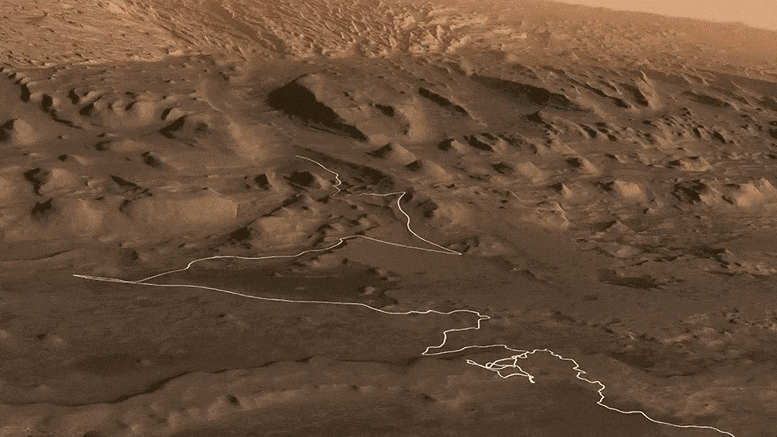
Posted on 08/13/2025 6:24:09 AM PDT by Red Badger

This view of tracks trailing NASA’s Curiosity was captured July 26, 2025, as the rover simultaneously relayed data to a Mars orbiter. Combining tasks like this more efficiently uses energy generated by Curiosity’s nuclear power source, seen here lined with rows of white fins at the back of the rover. Credit: NASA/JPL-Caltech Thirteen years into its mission, Curiosity is smarter and more efficient than ever. New multitasking abilities, self-managed naps, and clever engineering fixes are keeping it powered and mobile as it investigates ancient Martian landscapes for signs of past habitability.
Thirteen years after touching down on the Martian surface, NASA’s Curiosity rover is operating with more capability than ever before. Engineers have upgraded the six-wheeled explorer with greater autonomy and the ability to perform multiple tasks at once.
These changes are aimed at making the best possible use of Curiosity’s power supply, a multi-mission radioisotope thermoelectric generator (MMRTG). By improving efficiency, the rover can draw on ample energy reserves as it continues to investigate how Mars shifted from a planet with lakes and rivers to the cold, arid world we see today.

This is the same view of Curiosity’s July 25 mosaic above, with labels indicating some key parts of the rover involved in recent efficiency improvements, plus a few prominent locations in the distance. Credit: NASA/JPL-Caltech Exploring Mars’ Mysterious Boxwork Formations Recently, Curiosity arrived at an area covered in unusual geological patterns known as boxwork formations. These intricate ridges are thought to have formed when underground water left behind minerals billions of years ago. Spanning miles across this section of Mount Sharp, a towering 3-mile-high (5-kilometer-high) mountain, these formations may hold clues about whether microbial life could have survived beneath the surface during the planet’s gradual transition to dryness. Such findings could extend scientists’ understanding of how long Mars may have remained habitable.
Investigating these features requires substantial energy. In addition to driving and using its robotic arm to examine rock surfaces and cliffs, Curiosity must power a radio, cameras, and a suite of 10 scientific instruments. Multiple heaters are also needed to keep its electronics, mechanisms, and sensors functioning in Mars’ harsh conditions. Earlier missions, such as the Spirit and Opportunity rovers and the InSight lander, depended on solar panels to charge their batteries, but that approach always carried the risk of insufficient sunlight.
Curiosity, along with its newer counterpart Perseverance, instead relies on an MMRTG nuclear power source. This system generates electricity from the heat produced by decaying plutonium pellets, keeping the rover’s batteries charged. Known for their durability (the twin Voyager spacecraft have been operating with RTGs since 1977), these power units can keep missions running for years. However, as the plutonium fuel gradually decays, recharging the batteries takes more time, which means less energy is available for science activities each day.

This animation shows a proposed route for NASA’s Curiosity rover, which is climbing lower Mount Sharp on Mars. The annotated version of the map labels different regions that scientists working with the rover would like to explore in coming years. A flyover video explains them in more detail. Credit: NASA/JPL-Caltech Managing a Delicate Power Budget The team carefully manages the rover’s daily power budget, factoring in every device that draws on the batteries. While these components were all tested extensively before launch, they are part of complex systems that reveal their quirks only after years in the extreme Martian environment. Dust, radiation, and sharp temperature swings bring out edge cases that engineers couldn’t have expected.
“We were more like cautious parents earlier in the mission,” said Reidar Larsen of NASA’s Jet Propulsion Laboratory in Southern California, which built and operates the rover. Larsen led a group of engineers who developed the new capabilities. “It’s as if our teenage rover is maturing, and we’re trusting it to take on more responsibility. As a kid, you might do one thing at a time, but as you become an adult, you learn to multitask.”
Multitasking to Maximize Science Output Generally, JPL engineers send Curiosity a list of tasks to complete one by one before the rover ends its day with a nap to recharge. In 2021, the team began studying whether two or three rover tasks could be safely combined, reducing the amount of time Curiosity is active.
For example, Curiosity’s radio regularly sends data and images to a passing orbiter, which relays them to Earth. Could the rover talk to an orbiter while driving, moving its robotic arm, or snapping images? Consolidating tasks could shorten each day’s plan, requiring less time with heaters on and instruments in a ready-to-use state, reducing the energy used. Testing showed Curiosity safely could, and all of these have now been successfully demonstrated on Mars.

Curiosity viewed this rock shaped like a piece of coral on July 24, 2025. The rover has found many rocks that were formed by minerals deposited by ancient water flows. Credit: NASA/JPL-Caltech/MSSS Smarter Naps for Greater Efficiency Another trick involves letting Curiosity decide to nap if it finishes its tasks early. Engineers always pad their estimates for how long a day’s activity will take just in case hiccups arise. Now, if Curiosity completes those activities ahead of the time allotted, it will go to sleep early.
By letting the rover manage when it naps, there is less recharging to do before the next day’s plan. Even actions that trim just 10 or 20 minutes from a single activity add up over the long haul, maximizing the life of the MMRTG for more science and exploration down the road.
Years of Upgrades and Problem-Solving In fact, the team has been implementing other new capabilities on Curiosity for years. Several mechanical issues required a rework of how the robotic arm’s rock-pulverizing drill collects samples, and driving capabilities have been enhanced with software updates. When a color filter wheel stopped turning on one of the two cameras mounted on Mastcam, Curiosity’s swiveling “head,” the team developed a workaround allowing them to capture the same beautiful panoramas.
JPL also developed an algorithm to reduce wear on Curiosity’s rock-battered wheels. And while engineers closely monitor any new damage, they aren’t worried: After 22 miles (35 kilometers) and extensive research, it’s clear that, despite some punctures, the wheels have years’ worth of travel in them. (And in a worst-case scenario, Curiosity could remove the damaged part of the wheel’s “tread” and still drive on the remaining part.)
Together, these measures are doing their job to keep Curiosity as busy as ever.
More About Curiosity NASA’s Curiosity rover is a car-sized, six-wheeled robotic explorer designed to study Mars’ climate and geology and assess whether the planet once offered conditions favorable for microbial life. Built by NASA’s Jet Propulsion Laboratory (JPL) — managed by Caltech in Pasadena, California — the rover has been exploring the Red Planet since its landing in 2012. JPL leads the mission for NASA’s Science Mission Directorate in Washington as part of the broader Mars Exploration Program. Among its suite of advanced tools is Mastcam, a high-resolution camera system built and operated by Malin Space Science Systems in San Diego, which captures detailed images of Mars’ terrain and supports the mission’s ongoing scientific investigations.
MARS ROVER PING!................
Ping!.................
"Check out the big brain on Curiosity!"
As far as I’m concerned Mars rovers are a great investment until Elon can get us there.
The only movie I ever enjoyed that Sammie L was in....the rest I see his overt racism come through
The hardware and software people who constructed and manage Curiosity are probably not getting paid enough for what they do.
Google AI:
The Mars rovers, like Curiosity and Perseverance, have 256 megabytes (MB) of RAM. They also have 2 gigabytes (GB) of flash memory for storage, according to CNET. These rovers use a radiation-hardened BAE RAD750 microchip, operating at up to 200 megahertz.
256 MB? They should have had at least a gig or more...............
I agree. I’m sure future rovers will have more. It’s amazing what they’re doing with what they have. Hooray for plutonium pellet power source!
Can I get one?
Sorry, support for Windows 3.1 ended a few decades back..................

Crap!
Defund NASA. Shut it down.
Great! A Big Brain Upgrade - Why didn't they do the same for that Moron Biden, instead of making us suffer for four years?
Too busy doing Muslim outreach.............
In my experience with this sort of thing, that would be the last thing that motivates them.
Why? Only screen/mouse software must follow the Microsoft model of infinite bloat. Embedded devices rarely need so much. The memory assets of that thing are generous compared to actual needs. Also, I imagine the rover has a distributed control system.
I can do a great deal in small memories when it comes to monitor and control systems. It would be a safe bet that the processor and memory was over specified.
That’s good to know!🙂 I’m sure they love what they do!
Disclaimer: Opinions posted on Free Republic are those of the individual posters and do not necessarily represent the opinion of Free Republic or its management. All materials posted herein are protected by copyright law and the exemption for fair use of copyrighted works.